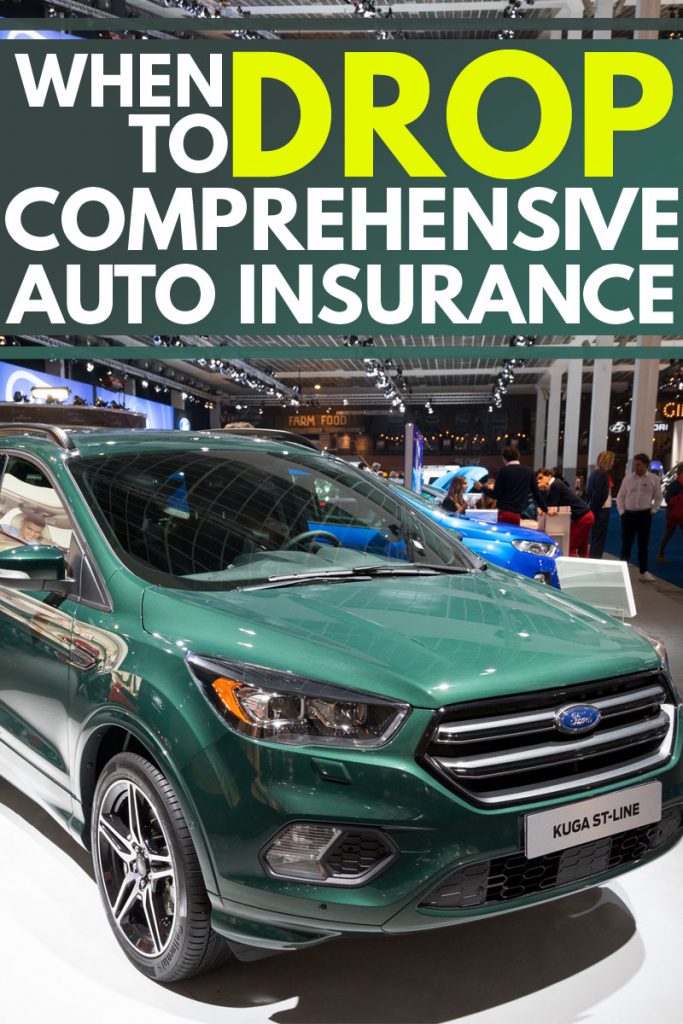Since car insurance can quickly become expensive, knowing when to drop comprehensive auto insurance can help save you money. Whether you have a brand-new car or a used one, you probably assume that more insurance coverage is better than less—to a point. But at what point should you drop comprehensive coverage?
Most drivers should drop comprehensive auto insurance if:
- The cost to fix the car exceeds its value. For example, a vehicle with a calculated worth of $1,000 won’t be covered if it sustains damage that requires $1,500 in repairs.
- You pay off a car and no longer must keep full coverage on it to meet lender requirements.

The problem is there’s no way to predict what amount of damage your car might sustain in a comprehensive-covered accident, or whether you’ll have one in the first place. And estimating repair costs and vehicle values is complicated, too. Fortunately, we’ll cover all the details in-depth so you can make the most informed decision on whether to drop comprehensive coverage.
Do You Need Comprehensive Auto Insurance on Older Cars?
Since comprehensive auto insurance covers incidents that are beyond your control, it’s tough to know whether you need it. After all, no one expects theft, vandalism, animal accidents, fallen trees or other acts of nature, fire, or glass damage with day-to-day driving. And with an older vehicle, it might not be worth a whole lot in the first place.
That said, depending on where you live, the type of vehicle you drive, and whether severe weather is typical, you might need comprehensive coverage. With older cars, the key is recognizing whether the policy cost makes sense, given the vehicle value.
When Does the Cost of Comprehensive Insurance Outweigh the Benefits?
The good news is, the average yearly comprehensive coverage cost is about $134. Therefore, the tradeoff can be worth it if your car needs repairs. At the same time, insurers aren’t going to pay out on a comprehensive claim that’s worth more than the value of your vehicle, no matter how much you’ve paid in. Instead, you’ll receive an amount equal to the value of the car, and it will be declared totaled.
You could pay into a policy for months or even years, then be denied repairs when you file a claim. Plus, you must pay your deductible before the insurer will fix your car or pay on it—and that can be a steep cost. If you keep the totaled vehicle and repair it, the insurer takes the salvage value out of the bottom-line payout. Then, your vehicle's title becomes a salvage title, which may mean that insurance companies opt not to insure it (but that's another subject entirely).
While monthly premiums are relatively low on comprehensive coverage, deductibles can range from a few hundred to nearly two thousand dollars. Of course, you can choose your deductible when applying for a policy, but the lower your deductible, the higher your monthly cost.
Does Comprehensive Coverage Make Sense on an Older Car?
Let’s say you do have risk factors for the type of damage that comprehensive policies cover—like living in an area with a high crime rate or somewhere with lots of overhanging trees that could fall. In that case, you need to consider whether comprehensive coverage makes sense.
Consider the value of your vehicle—and its depreciation—to figure out if the premiums you’ll pay will be worth it. Most of the time, premiums are doable—it’s the deductible cost you’ll need to think through.
To calculate whether comprehensive coverage is worth it, take these steps:
- Look at your car insurance policy to find your total premium amount and deductible.
- Estimate your car’s value; this is your starting figure
- Subtract the deductible amount from the car value
- Subtract from that amount the cost of your coverage for the policy period (the total premium divided by the coverage term)
If you get a negative number, that means your car’s value isn’t worth what you’re paying for comprehensive insurance. A small number—a few hundred or so—means you won’t see a big payout on your policy if your vehicle sustains heavy damage today. A large positive number means it’s likely worth keeping your coverage, especially if it’s not an amount you have on hand.
Should I Keep Collision Insurance on My Car?
While comprehensive coverage addresses non-accident incidents, collision coverage handles those direct hits with someone behind the wheel. From colliding with another vehicle to hitting an object or rolling the car, if you’re in the driver’s seat when the accident happens, it’s most likely a collision claim.
Like comprehensive, the decision to keep collision insurance depends on a cost-benefit analysis.
When Does the Cost of Collision Insurance Outweigh the Benefits?
The average cost of collision insurance is around $290 per year. Part of the reason for the higher premium cost is that collisions are more common than other types of claims—which is also a reason to consider such coverage. You’ll also pay a deductible before insurance repairs your car.
Like other types of insurance policies, your insurer won’t payout on a collision claim that surpasses the value of the car involved. While many comprehensive claims can be less expensive to address—like a cracked windshield—collision claims tend to be more severe.
In a rear-end collision, for example, you can expect a lot of structural damage to your vehicle that might be expensive or impossible to repair. When the cost of the insurance outweighs the potential payoff if your car is totaled, it’s not worth keeping collision coverage.
Does Collision Coverage Make Sense on an Older Car?
The calculation for determining whether collision coverage makes sense is the same as with comprehensive. Take the value of your vehicle, minus the collision deductible, and then subtract the total collision insurance cost to determine what amount the insurer is likely to pay out if you file a claim. This tells you whether it's worth your investment if your automobile gets totaled today.
Is it Better to Have Collision or Comprehensive?
For most drivers, you don’t have a choice of choosing one or the other policy (more on that below). But the answer to which coverage you truly need comes down to a combination of your driving habits, vehicle value, and luck.
Collision insurance covers your vehicle regardless of whose fault the accident is, but it only addresses accidents with cars or objects—plus rollover damage. Monthly costs are typically higher than comprehensive options. You might lean toward this option if you want to ensure your car is covered if an uninsured driver hits you, for example.
Comprehensive insurance addresses natural disasters, animal damage, cracked windshields, and other unpredictable elements. Monthly costs are usually lower than collision elements. You might favor this type of policy if severe weather patterns (like hail or windstorms) or animal issues (looting raccoons, bears, rodents who chew wires) are common in your area.
Of course, if you’re leasing or paying a loan on a vehicle, you probably don’t have much choice. In most cases, the lender or lease company will require both types to finance the automobile. If you don’t pay for full coverage, your loan could be canceled, and your vehicle repossessed.
Can You Have Collision Without Comprehensive?
With most insurance companies, comprehensive and collision insurance options are a package deal. But while you might have to pay for both, you can customize your premiums and deductibles to suit your budget and coverage needs.
For example, if you only want collision coverage, you can choose a higher deductible for the comprehensive portion, which will lower your monthly premiums. The opposite is also true, so you could have a lower deductible on comprehensive coverage and pay a bit more each month.
The best way to determine whether comprehensive insurance is a good deal—or if you should drop it—is to do the math. Check your existing policy—or a quote you obtain either online or through an insurance agent—and compare it with your auto value.
This way, you’ll have an accurate picture of what the costs of such insurance coverage are, and whether you should be shopping around or removing that coverage from your policy.



